Air Operations, Europe
The Luftwaffe raids airfields and towns in Holland, Belgium and northern France at dawn. German airborne forces invade Holland and Belgium, seizing key airfields and bridges; gliders land storm troops at Fort Eben-Emael in Belgium. The Dutch liners Statendam and Verndam are bombed and sink at Rotterdam. The Dutch air force and the RAF destroy many Junkers transport aircraft over Holland. RAF Battle bombers make low-level attacks on panzers advancing through Luxemburg (16 of 32 are shot down, the rest are damaged). In error German aircraft bomb Freiburg, Germany. 57 people are killed. Goebbels blames the French. 9 Belgian Fairey Fox biplanes intercept a group of Me-109s; 1 Me-109 is shot down. 3 Foxes are shot down and 6 are damaged. During the night the RAF launches its first strategic bombing raid on Germany. 8 Whitley bombers attack communication targets in the areas of Geldern, Goch, Aldekerk, Rees and Wesel in an effort to impede German troop and supply movements.
[Atlantic
British destroyers, minesweepers and Marines are sent to the coast of Holland.
[Battle of the Atlantic
- The Dutch steamer Boschdijk (6872t) is sunk at Rotterdam by German bombing.
- The French tug Calaisien (202t) is sunk in Calais by German bombing.
- The British steamer Henry Woodall (625t) is sunk on a mine 3 miles east of Withernsea with the loss of 7 crewmen. Survivors are picked up by the Estonian steamer Viiu.
- The German steamer Campinas (4541t) sinks on a mine at Drogden.
Britain, Politics
Churchill leaving Downing St with Sir Kingsley Wood and Anthony Eden |
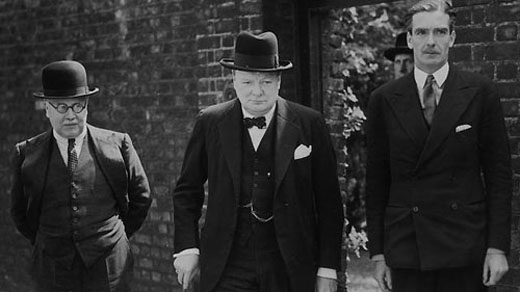 |
Luxembourg
Grand Duchy Overrun |
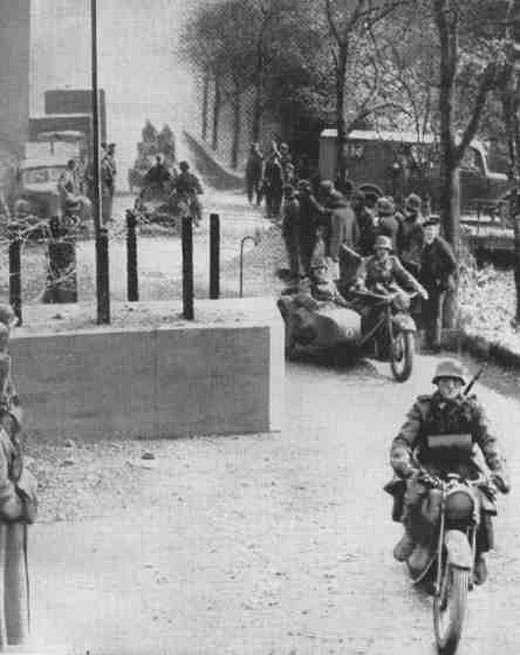 |
Diplomatic Relations
A 'Memoranda' is sent by the Germans to Brussels and The Hague justifying the invasion. Belgian and Dutch governments appeal to Britain and France. Queen Wilhelmina makes a 'flaming protest' against the unprovoked German aggression. The Luxemburg government flees to France. The British and French governments warn Germany against carrying out air raids on civilian targets.
[Iceland
Advance elements of a British force land on the island. Their mission is to set up a destroyer and scout-plane base to help in the convoy battles in the Atlantic. Also, they will prevent the Germans from using Iceland to aid in their U-boat campaign.
[North Sea
A German troopship is mined south of Oslo.
[Norway
British forces, including the 24th Guards Brigade, are sent south from Harstad to Mo-i-Rana to join the small units trying to delay the German advance and to relieve the Narvik force. Some of these units are now engaged at Mosjoen.
[Western Front
The Germans attack in the west begins. Their plans are for von Leeb's Army Group C to hold the frontier opposite the Maginot Line while von Rundstedt's Army Group A makes the main attack, with most of the armor, through the Ardennes and von Bock's Army Group B sends a secondary advance through Belgium and Holland to draw the main British and French forces north so that von Rundstedt can hit their flank. Neither the Belgians nor the Dutch have given the Allies any real cooperation in planning a joint defense because they do not wish to compromise their neutrality or provoke the Germans into attacking. The Allied Plan D is consequently less well elaborated than the German scheme. It provides for the French 1st Army Group, the BEF and the French 7th Army to advance to the line of the River Dyle and the Meuse above Namur, to be joined there by the Belgian forces and on the left to link with the Dutch. Gen Maurice Gamelin is the Supreme Commander, Gen Georges commands the armies on the Northeast Front, Gen Gaston Billotte the French 1st Army Group and Gen Lord Gort the BEF. Gort has the right to appeal to the British government if he believes that his orders from the French leaders threaten the existence of his force.
Germans Advance Into Luxembourg |
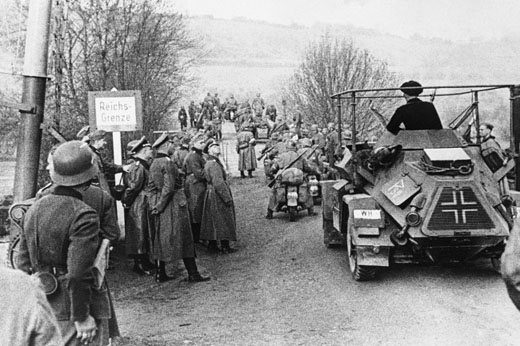 |
In theory the 2 sides are fairly evenly matched on the ground, the Germans having 136 divisions and the 4 Allies together 149. In tanks the Allied strength is somewhat greater and a number are of superior quality. Of course the Germans have the advantage that all their forces come under a single command and conform to one tactical system. In the air the Germans are very much stronger, with over 3,000 combat planes facing less than 2,000 of the Allies to which the British home-based bombers, about 500, can be added. Later more RAF fighters and bombers will take part in the battle, both from bases in France and England. Most of the Allied planes are of inferior types. The German organization and command are immeasurably superior. Their tanks are concentrated efficiently in armored divisions which are almost invariably energetically, and sometimes brilliantly, led. The higher command is not always ready to accept armored innovation but both individually and collectively it is still superior to the rambling Allied arrangements. Gamelin will take little real control of the operations and several of the French general officers will perform inadequately. The Allied troops of all nations are often poorly equipped and poorly led at more junior levels also. The tanks, especially the powerful French force, are mostly deployed in small infantry support units and will be let down by their poor mobility and defeated in detail. Although the British believe in the idea of the armored division they have not yet deployed one in France. (The 1st Armored Div will be ordered to France, incomplete, on May 11.)
German Panzers in the Ardennes |
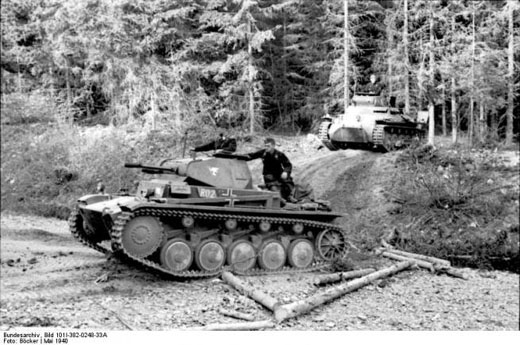 |
The distribution of the Allied forces also leaves much to be desired. The strongest and best-trained units are in the force to be sent forward in to Belgium with the best parts of the small reserve in support. Billotte's 1st Army Group includes almost all the armored units which the French army has formed. All 3 of the light armored divisions and 2 of the 3 heavy armored divisions are with the force which advances into Belgium and the infantry of the BEF and the French 1st Army are the best on the Allied side. The forces covering the Ardennes are weakest because the terrain in this sector is judged to be too difficult to allow a significant German attack. They have almost no reserves. The Maginot Line forces are stronger. In effect, the flanks are strong and the center, where the German attack falls, is weak.
On the first day von Rundstedt's forces immediately begin their advance through the Ardennes with the 3 armored corps in the van. Von Kleist has 2 Panzer corps under command, Guderian's XIX and Reinhardt's XLI and they are heading for Sedan and Montherme. Hoth's XX Pzr Corps is making for Dinant. The Belgian forces withdraw from the Ardennes to the River Meuse, except for 2 infantry companies, which delay the 1st Pzr Div of Guderian's corps with road blocks. The German advance is rapid and the little opposition, mostly French cavalry, is thrown aside.
Battle of the Hague |
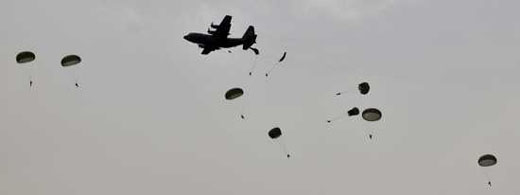 |
Far more spectacular and a far greater claim on Allied attention are the efforts of von Bock's Army Group B. Airborne troops land on the bridges at Rotterdam, Dordrecht and Moerdijk deep inside Holland which do much to paralyze Dutch resistance. German units cross the Maas near Arnhem in sudden early-morning attacks and, more exciting still, the fort at Eben Emael is put out of action by a German airborne force which lands its gliders literally on top of it. The fort, the key to the defence of Liège in Belgium, is meant to cover the crossings of the Albert Canal nearby and this is not achieved. The Luftwaffe gives powerful support.
The British and French react quickly to these attacks as soon as they hear of them from the Belgians. By the evening much of the Dyle line has been occupied but the troops find that there are no fortifications to compare with the positions they have prepared along the Franco-Belgian frontier during the Phony War. Some of the reserve is therefore committed to strengthen the line. Some of the advance forces of Giraud's 7th Army make contact with the Germans in southern Holland and are roughly handled.
At the end of the day the German advance has gone almost according to plan and the Allies are acting in the manner best calculated to improve the German success. Already it is becoming apparent that the Belgian and Dutch armies are going to fail to hold out long enough to receive British and French help. The main blow against the British and French has not yet fallen but it is being well prepared.[MORE]
Order of Battle - Germans -- French -- British
[